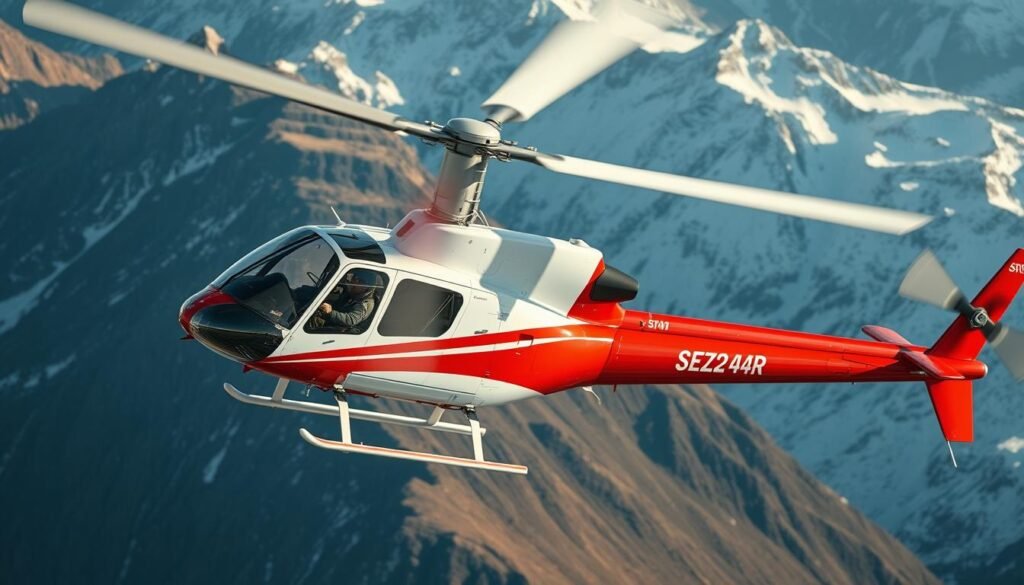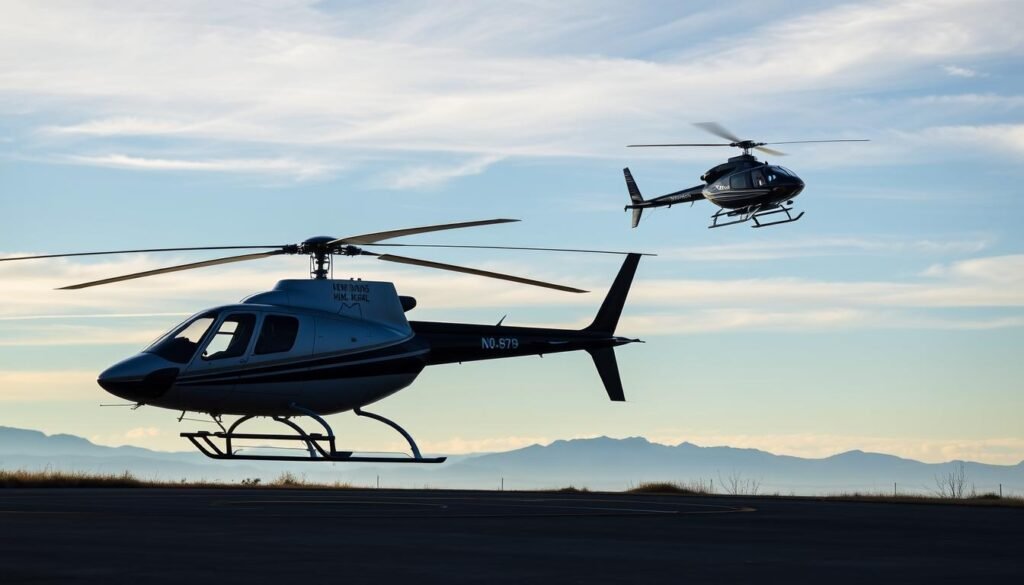Helicopter Pilot Salary starts with a striking benchmark: the national mean for civilian crews reached about $100,249 per year in mid‑2024, and Salary.com listed a typical range that tops out near $137,053.
That one number shows how quickly compensation can climb as professionals move from instruction roles into specialized missions. Readers will see the path from entry-level flight instructor pay to six-figure roles in private, corporate, and EMS operations.
The guide ties verified ranges to real job categories and the core factors that push earnings upward: role, documented hours, certification level, and mission type. For career context and additional benchmarks, consult a national survey or an industry breakdown like the one at flight trainers and a stage-by-stage analysis at Helicopted.
Key Takeaways
- Benchmarks Matter: Mid‑2024 averages provide a realistic pay baseline for U.S. roles.
- Pay rises predictably with hours, type ratings, and mission complexity.
- Instructor roles start lower but unlock pathways to EMS and private pay tiers.
- Compare base pay to total compensation, including bonuses and allowances.
- Use verified ranges to gauge where a career step will land financially.
Helicopter Pilot Salary Overview In The United States
Helicopter pilot salary benchmarks place a clear baseline: Salary.com reported an average figure near $106,617 (range $90,430–$137,053) in mid‑2024. Aggregated sources show civilian roles clustered around $100,249 annually, private operations commonly pay $90,000–$112,000, and flight instructors average roughly $66,000.
Pay varies by mission type and complexity. EMS roles often start lower ($60,000–$70,000) but can reach six figures in senior rescue crews. Private, corporate, and offshore jobs usually command higher pay because they require more type ratings, advanced training, and often longer duty hours.
Key factors that move the number include years of experience, logged flight hours, geographic demand, and employer type (public versus private or hospital‑based). Total compensation also reflects bonuses, per diem, and housing. Pilots should compare offers against national ranges and local costs to assess real pay and career trajectory.
Pay By Career Stage: From Flight School To Senior Captain
Compensation grows in clear stages as hours, ratings, and mission types stack together. This section maps typical steps from school instruction roles to senior command and highlights how time and targeted training change outcomes.

Certified Flight Instructor (CFI/CFII): Building Flight Hours Around $66,000
New instructors often earn roughly $66,000 while logging flight hours and sharpening teaching credentials.
Instructors use school networks and mentoring to convert teaching time into valuable endorsements and turbine readiness.
Early Career Pilots: Tours, Entry EMS, And Law Enforcement
Early roles—tour operations, entry EMS, or law enforcement—accelerate decision-making skills and real‑world experience.
These jobs commonly start near $60,000–$70,000 and fast‑track complex time that employers value later.
Mid-Career Pilots: Civilian And Private Roles Around The Six-Figure Mark
With years and the right ratings, many move into civilian and private work where earnings cross the six‑figure line.
Operators typically reward documented experience and mission complexity with higher base pay and benefits.
Senior And Specialized Pilots: Offshore Oil, VIP, And Corporate Transport
Senior roles in offshore, VIP, and corporate transport pay premiums due to risk, schedules, and certifications.
Military-To-Civilian Transitions: Leveraging Experience For Higher Pay
“Turbine time and leadership from military service often translate into stronger offers and faster promotions.”
Veterans convert high time and advanced training into marketable advantages when negotiating compensation.
- Tip: Seek roles that add NVG, IFR, and external‑load experience to boost marketability.
- Path: Use instructor duty and school contacts to target openings listed at training and pay resources.
- Resource: Compare starting ranges via a role breakdown like the entry-level pay guide.
Helicopter Pilot Salary: Key Factors That Move The Pay Range
Real jumps in income follow clear, trackable gains in experience and mission complexity. Compensation in this field reflects measurable inputs. Employers reward specific credentials, recent operational time, and mission depth.

Flight Hours And Years Of Experience
Flight hours are the most visible metric. Recent turbine time, night work, and complex missions raise the band faster than total hours alone.
Employer Type And Rank: From First Officer To Captain
Employer type sets base tiers. Hospital EMS, corporate departments, and offshore firms offer different pay and benefits.
Rank matters: first officers get experience; captains get responsibility and higher compensation.
Geographic Location And Cost Of Living
High-demand regions and costly metro areas lift total compensation. Remote postings may add per diem and housing allowances.
Skills, Training, And Certifications That Command Premiums
Targeted skills — NVG, IFR, mountain and external-load work — unlock premiums. Certifications and current currency broaden mission eligibility.
“Documented, recent mission time and targeted training create the strongest leverage at hiring and review.”
| Factor | How It Moves Pay | Typical Impact |
|---|---|---|
| Flight Hours | Recent turbine and NVG time increase offers | Medium–High |
| Employer Type & Rank | Corporate/offshore pay more than entry EMS; captains outrank first officers | High |
| Certifications & Skills | IFR, NVG, and external‑load open premium roles | High |
| Location & Demand | High-cost areas and sector hiring surges improve offers | Variable |
Track hours by type and carry documentation. For a deeper look at market benchmarks and career moves, consult this professional earnings guide.
Pay By Role And Industry: EMS, Private, Offshore, And More
Compensation changes sharply across roles; each industry track defines its own pay curve and progression.

Emergency Medical Services (EMS): From $60,000-$70,000 Starting To $150,000
EMS entry pay commonly runs $60,000–$70,000. With advanced medevac experience, NVG/IFR currency, and senior crew roles, total compensation can approach $150,000.
Mission complexity, night work, and regional demand drive raises more than time alone.
Private And Civilian Pilots: Averages Near $100,000 And Above
Civilian and private roles cluster around an average of $100,249. Many private operators pay $90,000–$112,000, with top positions near $117,000 when benefits and bonuses are included.
Benefits and perquisites often push total pay above base figures.
Offshore Oil And Gas Support: Among The Highest-Paying Pilot Jobs
Offshore work is typically among the highest-paying tracks due to long rotations, specialized aircraft, and demanding schedules.
Rotational packages often add per diem, housing, and roster premiums that materially increase total compensation.
Touring, Law Enforcement, And Search And Rescue
Tour operations, law enforcement, and search rescue offer varied pay but excellent operational exposure.
That exposure — especially NVG, external‑load, and complex night missions — helps crews transition into higher-paying corporate or offshore roles.
“Operators pay for relevant, current mission time. Documented medevac response metrics and mission stats make a measurable case for higher offers.”
- Compare base pay with extras: bonus, per diem, housing, and roster matter for rotational posts.
- Target high‑need regions and growing operators to increase leverage.
- Track hours by mission type to show value when negotiating offers; metrics translate to higher pay.
- For market context and negotiating data, consult a detailed guide like this career salary guide.
Verified Ranges And Benchmarks To Set Expectations
Benchmark data helps professionals separate headline pay from realistic, recurring compensation.

National Averages: Salary.com, Glassdoor, And Aggregated Sources
Salary.com lists a U.S. average of $106,617 with a range of $90,430–$137,053 (June 27, 2024).
Aggregated sources place civilian roles near $100,249 and private averages around $90,000–$112,000. EMS ranges start lower and can climb with experience.
Base Pay Versus Total Compensation: Bonuses, Tips, And Profit Sharing
Base pay is one part of total compensation. Bonuses, commission, tips, and profit sharing often push the final number higher.
Compare offers by adding estimated additional pay to the base so apples are compared to apples.
Florida Example: Interpreting Total Pay Estimates
Glassdoor’s Florida figures show an average base near $129,874 and estimated additional pay of $78,753, giving total pay roughly $208,627.
Use the “Most Likely Range” percentiles to focus on typical offers, not top-end outliers.
| Source | Reported Base | Additional Pay | Typical Range |
|---|---|---|---|
| Salary.com | $106,617 | Varies | $90,430–$137,053 |
| Aggregated U.S. | $100,249 | Bonuses/Per Diem | Private $90k–$112k; EMS wide |
| Glassdoor (FL) | $129,874 | $78,753 est. | Total ~$208,627 |
“Check percentiles and normalize for aircraft type, roster, and mission when benchmarking against national data.”
For a sector survey and negotiating context, review the 2024–2025 survey.
How To Increase Your Pay: Degrees, Ratings, And Strategic Moves
Adding targeted credentials and making strategic job moves is the fastest way to improve income in a flight career.
Plan training around high‑value mission sets and focus on credentials that open premium roles. Recent, documented experience matters as much as total time.

Add High‑Value Ratings: Instrument, NVG, External Load, Mountain, Turbine
Prioritize an instrument rating, NVG currency, external‑load and mountain training, and a turbine transition. These certifications unlock EMS, offshore, and corporate/VIP jobs that pay more.
Maintain currency with recurrent checks so the skills are current when recruiters vet candidates.
Earn A Bachelor’s Degree While Instructing To Grow Hours And Income
Many choose to work as a certified flight instructor while finishing a degree. This path funds building flight hours and improves marketability.
A bachelor’s expands access to employer programs, grants, and more competitive job ladders.
Target High‑Demand Sectors And Markets For Faster Salary Growth
Move toward EMS, offshore, or corporate tracks in regions with high demand to compress the time to higher pay.
- Track flight hours by mission type—night/NVG and IFR—to show direct value.
- Use school networks and mentors to time checkrides and openings.
- Understand rosters, per diem, and bonus plans to negotiate total compensation.
- Build safety and leadership records for future training or chief roles that increase money and responsibility.
“Documented, recent mission time and targeted training create the strongest leverage at hiring and review.”
Conclusion
Clear pay bands form as experience, training, and mission profile accumulate over a career. U.S. civilian compensation commonly centers near $100,000, with Salary.com reporting about $106,617 and a typical range of $90,430–$137,053.
Entry EMS starts near $60,000–$70,000 and can rise toward $150,000 with advanced roles. Private roles often fall between $90,000–$112,000. These figures show how verified flight hours, targeted certifications, and mission depth move the numbers.
Practical guidance: track hours by mission type, follow a structured training path, and weigh base pay against per diem, bonuses, and benefits. For a focused market review, see pilot pay trends.
FAQ
What are typical pay ranges by career stage for rotorcraft aviators?
Entry-level instructors who build hours as Certified Flight Instructors commonly see total compensation near $66,000. Early-career crew members in tours, EMS, and law enforcement often earn between $60,000 and $80,000. Mid-career professionals in private and corporate roles frequently reach six figures. Senior and specialized operators in offshore oil, VIP transport, and corporate aviation can exceed that, with top roles paying well into the six figures depending on experience and contract terms.
How does the U.S. national market affect remuneration for rotorcraft operators?
National benchmarks from sources like Salary.com and Glassdoor provide a baseline but vary widely by region, employer type, and demand. Aggregated data shows wide ranges; base pay often differs from total compensation once bonuses, overtime, and profit sharing are included. Urban and coastal markets typically pay more, while rural postings may offer lower base rates but other benefits.
How many flight hours and years of experience influence pay progression?
Flight time and years logged remain the strongest pay drivers. Building hours through instructional roles or commercial contracts accelerates progression. Typical thresholds—1,000–1,500 hours for better entry roles, 3,000+ for solid mid‑career placement, and military or turbine experience for senior hire—translate directly into higher offers.
What employer types and ranks yield higher compensation?
Operators employed in offshore support, corporate/VIP transport, and contracted government work tend to pay more. Rank matters: Captains and check airmen command higher pay than first officers. Companies that require type ratings, turbine time, or specialized qualifications often offer premium pay or signing bonuses.
Which skills and certifications most increase earning potential?
High‑value ratings such as instrument, night vision goggle (NVG), external load, mountain operations, and turbine type ratings raise marketability. A Certified Flight Instructor credential accelerates hour-building. Advanced training, recurrent type checks, and safety course completion further enhance bargaining power.
How do industry sectors compare: EMS, private, offshore, touring, and law enforcement?
EMS roles start around $60,000–$70,000 and can scale to $150,000 with experience and niche skills. Private and corporate positions average near $100,000 and rise with client demand. Offshore oil and gas support frequently offers some of the highest pay due to operational risk and specialized requirements. Touring, law enforcement, and search‑and‑rescue roles vary; pay depends on agency budgets, union status, and overtime opportunities.
How should pilots interpret base pay versus total compensation?
Base pay covers regular wages, while total compensation includes bonuses, overtime, per‑diems, health benefits, retirement contributions, and profit sharing. Positions with lower base but generous per‑diems or flight pay can rival higher base salaries. Review contracts carefully for guaranteed minimums and variable pay components.
Are there regional examples that illustrate pay differences?
States with high demand and higher cost of living, like Texas, California, and Florida, often show higher posted pay. For instance, Florida roles may offer competitive total pay due to tourism and offshore operations; however, living costs and seasonal fluctuations can affect net income and job stability.
What strategic moves accelerate income growth?
Earning advanced ratings, obtaining a bachelor’s degree while instructing, and targeting high‑demand sectors speed progression. Moving to busy geographic markets, pursuing turbine and NVG qualifications, and accepting short‑term offshore or contract roles can produce faster pay increases.
How does military experience translate to civilian compensation?
Former military aviators often carry strong advantages: high turbine hours, systems experience, and disciplined training. Civilian employers prize that background and may offer higher starting pay or senior placement. Transition pay varies with the relevancy of logged hours and civilian certifications.
What common mistakes reduce earning potential?
Ignoring high‑value ratings, staying in low‑demand markets too long, and failing to track logbooks and endorsements harm negotiating leverage. Also, accepting roles without reviewing total compensation details, duty time, and contract terms can limit long‑term income growth.
Where can professionals find reliable benchmarks and job listings?
Industry sites such as Vertical Magazine, Professional Pilot, Glassdoor, and job boards maintained by operators and government agencies provide current listings and compensation data. Professional associations and unions also publish surveys and regional pay scales that help set realistic expectations.
Related Articles
- Women in Helicopter Aviation: Breaking Barriers and Building a Career
- Freelance Helicopter Pilots: How to Build a Successful Career
- Helicopter Pilot Licensing Requirements: A Global Overview
- How to Network and Advance Your Career as a Helicopter Pilot
- What to Expect in Your First Year as a Commercial Helicopter Pilot
More from This Category
- Work-Life Balance for Helicopter Pilots: Managing a Demanding Career
- How to Transition from Fixed-Wing to Helicopter Flying: Tips for Pilots
- The Best Industries for Helicopter Pilots: Job Opportunities Beyond Passenger Transport
- Medical Requirements for Helicopter Pilots: What You Need to Know
- How to Build Flight Hours as a New Helicopter Pilot
- Essential Skills Every Helicopter Pilot Needs to Succeed
- Top Helicopter Pilot Training Schools: How to Choose the Best Program
- Private vs. Commercial Helicopter Pilot: Which Career Path Is Right for You?
- Helicopter Pilot Salary: What You Can Expect at Every Stage of Your Career
- How to Become a Helicopter Pilot: A Step-by-Step Guide



